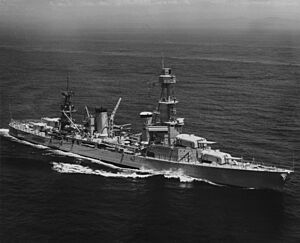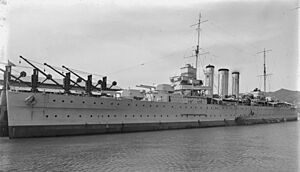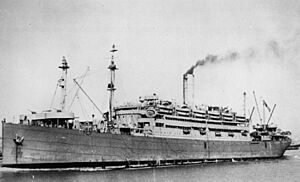Pensacola Convoy facts for kids
The Pensacola Convoy was a group of U.S. military ships that sailed in late 1941, just as World War II was starting in the Pacific. It got its name from its main escort ship, the large cruiser USS Pensacola. This convoy was sent during peacetime to help protect the Philippines, which was a U.S. territory at the time.
The ships were carrying important supplies like artillery, aircraft, ammunition, and fuel. They also carried thousands of American soldiers and airmen. The goal was to make the Philippines stronger against a possible attack from Japan. However, after Japan attacked Pearl Harbor and the Philippines, the convoy had to change its plans and was sent to Brisbane, Australia, instead.
Contents
Why the Convoy Sailed
In August 1941, the U.S. military decided to send a lot of help to the Philippines. General Douglas MacArthur, who was in charge of U.S. forces there, was told that the first groups of soldiers would sail soon. The U.S. wanted to make sure its forces in the Philippines had the best equipment and enough people.
Convoys, which are groups of ships traveling together for safety, started sailing in September 1941. They continued through November, always escorted by a Navy ship from Pearl Harbor, Hawaii.
Ships and Supplies
The Pensacola convoy included several important ships:
- The gunboat USS Niagara
- U.S. Navy transport ships USS Republic and USS Chaumont
- U.S. Army transport ships USAT Willard A. Holbrook and USAT Meigs
- U.S. merchant ships Admiral Halstead and Coast Farmer
- The Dutch merchant ship Bloemfontein
The convoy carried about 2,000 National Guard troops. These soldiers were part of artillery units, including:
- The 2nd Battalion, 131st Field Artillery Regiment from Texas.
- The 1st and 2nd Battalions, 147th Field Artillery Regiment from South Dakota.
- The 1st Battalion, 148th Field Artillery Regiment from Idaho.
About 2,600 U.S. Army Air Forces personnel were also on board. They brought aircraft that were taken apart and packed in crates:
- Fifty-two Douglas A-24 dive bombers were on the Meigs.
- Eighteen crated Curtiss P-40 fighter planes were on the Bloemfontein.
- Many pilots traveled on the Republic and Holbrook.
The ships also carried a lot of equipment:
- 20 field artillery guns.
- Anti-aircraft ammunition.
- Thousands of bombs.
- 340 motor vehicles.
- 9,000 barrels of aviation fuel.
- Over half a million rounds of .50 caliber ammunition.
- Nearly 10,000 anti-aircraft shells.
The Convoy's Journey
The ships left San Francisco at different times and met up at Pearl Harbor, Hawaii, on November 27. From there, the convoy sailed towards Manila on November 29, taking a longer, southern route.
On December 7, news reached the convoy that Japan had attacked Pearl Harbor. Suddenly, the world was at war. The crews and soldiers quickly started painting over the ships' civilian colors with gray paint to make them harder to see. Extra lookouts were posted to watch for Japanese planes, submarines, and ships. Everyone on board was ordered to wear life jackets and carry water. Life rafts were also put on deck.
Japanese forces landed in the Philippines on December 8. Because of this, the convoy was told to stop at Suva, Fiji, while leaders decided what to do next.
Change of Plans
Over the next few hours, it became clear that Japan was quickly winning battles in the Philippines and other parts of Southeast Asia. U.S. military leaders discussed whether to send the convoy back to Pearl Harbor or even back to the United States.
However, President Franklin D. Roosevelt suggested that the supplies should still go to the Southwest Pacific. So, it was decided that the convoy would go to Brisbane, Australia, instead of the Philippines.
The convoy reached Suva on December 12. Australian warships, including HMAS Canberra and HMAS Perth, were sent to meet them and help escort them.
The convoy then sailed from Fiji in a zigzag pattern to avoid submarines. To save food, soldiers were given only two meals a day. On December 19, near New Caledonia, the escort ships were joined by HMAS Canberra, HMAS Perth, and HMNZS Achilles. As they got closer to Brisbane, Royal Australian Air Force planes and more Australian ships, HMAS Swan and HMAS Warrego, provided protection.
Meanwhile, U.S. Navy leaders wondered how the convoy could ever reach Manila, as Japanese forces were blocking the way. General MacArthur believed it was possible with enough naval and air support.
Arrival in Australia
The situation changed on December 22 when Japanese forces began landing in Lingayen Gulf in the Philippines. On that same day, the convoy arrived in Brisbane, Australia, with its Australian escorts.
The arrival of the convoy was a big deal in Australia. These were the first U.S. soldiers on Australian soil during the war. At this time, Australia felt threatened by Japan, and many of its own best soldiers were fighting in other parts of the world. The U.S. soldiers stayed in tents at Ascot Racecourse (now Eagle Farm) while they waited for new orders.
It was decided that the most important equipment would be flown to Manila. However, there were problems: the fighter planes didn't have engine coolant, and the dive bombers were missing parts like trigger motors and gun mounts. These issues happened because loading was done quickly in peacetime, and there wasn't a clear system for packing everything together. For example, some small but vital parts were accidentally nailed inside packing crates and burned with the crates.
The Pensacola was ordered to escort some of the convoy ships as far as the Torres Strait before returning to the fleet. On December 28, after six days of unloading, two artillery battalions sailed on the Holbrook and Bloemfontein. These were the fastest ships, and they were headed for Manila. However, Japan had set up bases in Borneo, making it very hard to reach the Philippines. Most of the troops were unloaded at Darwin, Australia, with some sent to Surabaya, Java.
What Happened Next
The Bloemfontein, with an escort of U.S. Navy ships, was able to take the 2nd Battalion, 131st Field Artillery to Surabaya, Java, arriving on January 11, 1942. This battalion fought bravely in the Battle of Java in March 1942. Most of its soldiers became POWs after the Allied forces surrendered.
Seventeen of the eighteen P-40 fighter planes were quickly put together. They were assigned to a new squadron formed by pilots who had flown from the Philippines. However, Japan's advances made it impossible to fly the planes back to the Philippines. The squadron flew its planes across northern Australia to Darwin, then to Java. On March 1, the squadron left Java, giving its remaining planes to the Dutch military.
Eleven of the A-24 dive bombers reached Java on February 11. All of them were lost in battle. Others were later shot down in July 1942 while attacking Japanese ships near Buna, New Guinea.
The 147th and 148th Field Artillery Regiments from the convoy were sent to Darwin to help defend northern Australia. These units later became artillery battalions and served in the Southwest Pacific.
The USS Pensacola itself went on to fight in many important battles during World War II before being taken out of service in 1946.
Images for kids





